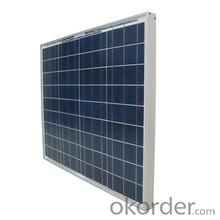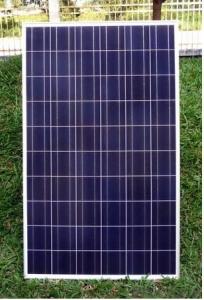Monocrystalline Solar Module 205W with Outstanding Quality and Price
- Loading Port:
- Shanghai
- Payment Terms:
- TT OR LC
- Min Order Qty:
- 100 watt
- Supply Capability:
- 10000 watt/month
OKorder Service Pledge
OKorder Financial Service
You Might Also Like
Item specifice
Monocrystalline Solar Module 205W with Outstanding Quality and Price
Production Description
solar cell (or a "photovoltaic" cell) is a device that converts photons from the sun (solar light) into electricity.
In general, a solar cell that includes both solar and nonsolar sources of light (such as photons from incandescent bulbs) is termed a photovoltaic cell.
Fundamentally, the device needs to fulfill only two functions: photogeneration of charge carriers (electrons and holes) in a light-absorbing material, and separation of the charge carriers to a conductive contact that will transmit the electricity.
This conversion is called the photovoltaic effect, and the field of research related to solar cells is known as photovoltaics.
Solar cells have many applications.
Historically solar cells have been used in situations where electrical power from the grid is unavailable, such as in remote area power systems, Earth orbiting satellites, consumer systems, e.g. handheld calculators or wrist watches, remote radio-telephones and water pumping applications.
Solar cells are regarded as one of the key technologies towards a sustainable energy supply.
A solar cell, or photovoltaic cell, is an electrical device that converts the energy of light directly into electricity by the photovoltaic effect, which is a physical and chemical phenomenon.[1] It is a form of photoelectric cell, defined as a device whose electrical characteristics, such as current, voltage, or resistance, vary when exposed to light. Solar cells are the building blocks of photovoltaic modules, otherwise known as solar panels.
Application
remote area home system
earth orbiting satellites
consumer system
water pumping system
residential
commercial
industrial
rooftop
Product Feature
Higer convension than the poly solar module
12 years product warranty
A grade solar panel with good surface looking
EVA tempered glass TPT
MC4 connecter
Package
24pcs into one carton 312pcs into a 20 foot container.
- Q:With no moving parts, no fuel piping and so on...
- ITS TO DO WITH THE PRODUCTION PROCESS
- Q:What is the warranty period for solar panels?
- The warranty period for solar panels typically ranges from 10 to 25 years, depending on the manufacturer and the type of panel.
- Q:Can solar panels be installed on government buildings?
- Yes, solar panels can be installed on government buildings. In fact, many governments around the world have already embraced solar energy and installed photovoltaic systems on their buildings as part of their commitment to renewable energy and sustainability. This helps reduce the carbon footprint of government operations and serves as a positive example for the community.
- Q:Are solar panels affected by shade?
- Yes, solar panels are affected by shade. Shading can significantly reduce the efficiency and overall energy production of solar panels. It is important to ensure that solar panels are installed in areas with minimal shade to maximize their performance.
- Q:Are there any limitations to the lifespan of solar panels?
- Yes, there are limitations to the lifespan of solar panels. While most solar panels are designed to last for several decades, their efficiency gradually decreases over time. Factors such as weather conditions, shading, and quality of materials can impact their lifespan. Additionally, some components, such as inverters, may need to be replaced after a certain period. However, with proper maintenance and regular inspections, the lifespan of solar panels can be maximized.
- Q:If my school uses 88240kWh of electricity per month and I have 000 50W solar panels running for 6 hours a day, does it mean it will take 88240kWh / {{[(50W x 3600s)*000]/000}kWh x 6} number of hours to generate that much electricity (88240kWh)?
- your first question: Does a 50W solar panel generate 540kWh? 540 kW-hr / 50W = 3600 hours it would take that long for the panel to generate that amount of energy. your second question is confused, as you both stipulate the number of hours at 6 hours per day, and you try to solve for the number of hours. 000 x 50w = 50 kW 50 kW x 6 hr/day x 30 day/mo = 27000 kW-hr/mo = 27 MW-hr/mo that is the amount of energy generated. That is nowhere close to 88240 kWh or 88 MW-hr. I would take 7 times more solar panels to generate that much energy. .
- Q:if so, would it be possible to make (or remake) an organism that could subsist off of sunlight and external heat like plants?
- There are, in fact, protozoa that use chlorophyll to harvest sunlight, but the thing is, they also MOVE. So it's not entirely unreasonable that an animal cell could do the same.
- Q:Ok, so my homework was to research and write about how solar panels and solar furnaces work and about their construction. We didn't even take one lesson on it in class and we are not allowed to copy and paste much and have to keep it simple wtf? Its soo annoying as we have hardly took it in class. Please can someone help.
- A solar panel (photovoltaic module or photovoltaic panel) is a packaged, connected assembly of solar cells, also known as photovoltaic cells. The solar panel can be used as a component of a larger photovoltaic system to generate and supply electricity in commercial and residential applications. Because a single solar panel can produce only a limited amount of power, many installations contain several panels. A photovoltaic system typically includes an array of solar panels, an inverter, and sometimes a battery and interconnection wiring.
- Q:I have made a 5v dc 52watt solar panel and I going to be trying to charger 4 2v dc 55ah batteries. I get about 6 hours of sun on my panel. Spec below, is that a big enough panel to charge the batteries???I have 30 3x6 solar cells wired together Cell Specifications: (Watts): .75 Wp (Amps): 3.5 Imax (Volts): 0.5 V max which is where I got my 5g 52watt max (if math is wrong plz tell me) The Battery type: 2Volt 55.0ah NB Sealed Lead Acid Battery. I am using a mppt solar charger.
- OK your math on the solar panel looks correct, but you are missing some critical information. What is the load on your batteries and for how long is this load being applied. Calculate the amp-hour load to see if your solar panel can recharge your batteries with the amount of sun light available. A safe engineering standard is to have twice as much capability as required. If you have a 200 amp load for 7.5 minutes, this would be a 25 amp-hour discharge and will take your solar panel over 7 hours to recharge your batteries. Your solar panel can easily charge the batteries up to full capacity with out any load on the batteries, if the batteries are 50% discharged, this will take about 32 hours. CAUTION! I am assuming that you are hooking the batteries up in a parallel connection, that will give you over 200 amps of current. You should charge each battery up to full charge before you connect them together, if they are not at the same exact voltage when you connect them together, they will self adjust so that each battery is at the same voltage level, at 55 amps this could be a very large spark. Each cell, there are six (6) cells in a 2 volt battery, should be at 2.7 to 2.2 volts DC per cell at full charge. Make sure your battery has a voltage 3.02 to 3.26 volts open circuit or no load. This should be full charge if your batteries do not have this voltage level, say one battery is at 0 volts DC, it could have a dead or shorted cell. DO NOT use this battery until you can get it to hold a 3.02 to 3.26 volt DC level.
1. Manufacturer Overview |
|
|---|---|
| Location | |
| Year Established | |
| Annual Output Value | |
| Main Markets | |
| Company Certifications | |
2. Manufacturer Certificates |
|
|---|---|
| a) Certification Name | |
| Range | |
| Reference | |
| Validity Period | |
3. Manufacturer Capability |
|
|---|---|
| a)Trade Capacity | |
| Nearest Port | |
| Export Percentage | |
| No.of Employees in Trade Department | |
| Language Spoken: | |
| b)Factory Information | |
| Factory Size: | |
| No. of Production Lines | |
| Contract Manufacturing | |
| Product Price Range | |
Send your message to us
Monocrystalline Solar Module 205W with Outstanding Quality and Price
- Loading Port:
- Shanghai
- Payment Terms:
- TT OR LC
- Min Order Qty:
- 100 watt
- Supply Capability:
- 10000 watt/month
OKorder Service Pledge
OKorder Financial Service
Similar products
New products
Hot products
Hot Searches




























